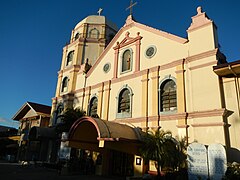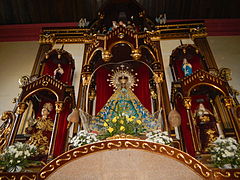Obando Church
| Obando Church | |
|---|---|
| San Pascual de Baylon Parish Church National Shrine of Our Lady of the Immaculate Concepcion of Salambao | |
 Obando Church | |
 Obando Church Location in the Philippines | |
| 14°42′38″N 120°56′13″E / 14.710556°N 120.937028°ECoordinates: 14°42′38″N 120°56′13″E / 14.710556°N 120.937028°E | |
| Location | Obando, Bulacan |
| Country | Philippines |
| Denomination | Roman Catholic |
| Website | [1] |
| History | |
| Status | Parish church and National Shrine |
| Founded | April 29, 1754 |
| Founder(s) | Fray Manuel De Olivencia |
| Dedication | Saint Paschal Baylon |
| Dedicated | December 1, 2007 |
| Architecture | |
| Functional status | Active |
| Architectural type | Church building |
| Administration | |
| Archdiocese | Manila |
| Diocese | Malolos |
| Clergy | |
| Archbishop | Luis Antonio Tagle |
| Bishop(s) | Dennis Cabanada Villarojo |
| Priest(s) | Proceso Espiritu |
| Assistant priest(s) | John Michael Dela Cruz |
The Parish of San Pascual Baylon and National Shrine of Nuestra Señora Inmaculada Concepcion de Salambao (Tagalog: Parokya ni San Pascual Baylon at Pambansang Dambana ng Nuestra Señora Inmaculada Concepcion de Salambao), also known as Obando Church,[1][2] is a Roman Catholic church located in the municipality of Obando in the province of Bulacan, Philippines. Founded by Franciscan missionaries, under the Spanish Empire, it is the venue of the three-day Obando Fertility Rites held annually in honor of three patron saints, namely: St. Pascual Baylon, St. Claire of Assisi and Our Lady of Salambao,[3] a celebration that was mentioned by Jose Rizal, the Philippine national hero, in the pages of his Spanish-language novel, the Noli Me Tangere (in Chapter 6: Captain Tiago). During the month of May, parishioners and other devotees perform the three-day Obando Dance (formerly known as the Kasilonawan, now locally called Sayaw sa Obando, literally "the dance in Obando") inside the church, followed by a street procession.[4]
Structure[]
Its façade had been described as similar to that of the church of Marilao, Bulacan. The edifice is composed of windows and flat columns, and has a pediment with a niche and two round windows at the sides. The façade is also flanked by an octagonal belltower.[1] Connected to its structure is the Colegio de San Pascual Baylon, a private school managed by the parish. The altar of the church is believed to be gilded with silver.[4]
History[]
The Obando Church was built by the Franciscan Order, headed by Rev. P. Manuel de Olivencia, the first curate of Obando, on April 29, 1754. The church was destroyed in World War II during the fight for the liberation from the Japanese rule. According to some reports, the original statues of Our Lady of Salambao, Saint Clare and Saint Paschal Baylon were also destroyed during the fighting, and that the images presently venerated are commissioned replication of the original images.[5] The church was rebuilt in 1947 through the efforts of Rev. Fr. Marcos C. Punzal[2][6] with the help of local Obandeño parishioners.[3]
Other parish priests who also managed the Obando Church since the 1900s include: Rev. Fr. Juan Dilag, Rev. Fr. Padre Exequiel Morelos, Rev. Fr. Ricardo Pulido, Rev. Fr. Marcos Punzal, Rev Msgr. Rome R. Fernandez, Rev. Fr. Marcelo K. Sanchez, Rev. Fr. Danilo G. delos Reyes, Rev. Fr. Avelino A. Sampana, and Rev. Fr. Virgilio C. Ramos.[2] It was Rev. Fr. Rome Fernandez, with the assistance from the Cultural Commission of Obando, who revived the celebration of the Obando Fertility Rites or the Obando Dance in 1972. This was after a prohibition of the practice was imposed by an archbishop of Manila after World War II.[7]
Current status[]
The Church of Obando has been declared as the "Diocesan Shrine" of the Our Lady of the Immaculate Concepcion of Salambao by the Catholic Church on December 1, 2007.
The church is connected to several barangay chapels in Obando, Bulacan, namely Panghulo, Catanghalan, Pag-asa, Paliwas, San Pascual, and Hulo. Two former chapels that now have parochial church statuses: the Santa Cruz Parish in Paco and the Parish of Our Lady of Salambao in Binuangan. Both are still within the political boundaries of present-day town of Obando.
At present, Obando Church is managed by its parish priest, Rev. Fr. Proceso Espiritu, since his installation in 2021.[2]
On January 28, 2021, Obando Church was elevated to the rank of National Shrine by the Catholic Bishops' Conference of the Philippines, raising the number of national shrines in the country to 27.[8]
Gallery[]
Facade of the Obando Church
Main altar
Processional Icon of Paschal Baylon in the Church
Icon of Baylon in altar
St. Claire of Assisi in the altar
Our Lady of Salambao and the saints in the altar
Our Lady of Salambao in the altar
Side altar of St. Joseph and Child Jesus
Side altar of Virgin Mary
See also[]
References[]
- ^ Jump up to: a b Visita Iglesia, the Old Churches of Bulacan Part 2 of 2. Simbahan: Philippine Heritage Churches and Related Structures,17 March 2008
- ^ Jump up to: a b c d "Kasaysayan ng Simbahan ng Obando." (History of the Obando Church), Obando, Bayang Pinagpala! (Obando, Blessed Town!), Pamahalaang Bayan ng Obando (Local Government of Obando), 2006/2007
- ^ Jump up to: a b Obando Church Archived 2007-07-12 at the Wayback Machine, Religious, Things to Do and see in Bulacan, Bulacan, WowPhilippines.com
- ^ Jump up to: a b Philippines Obando Church Interior, Obando, Bulacan, ca. early 1900s, Teleguam.net
- ^ Atanacio, Jovi. "Our Lady of Salambao of Obando, Bulacan". Philippine Marian Site. Retrieved on 2014-10-30.
- ^ The correct spelling of Rev. Fr. Marcos C. Punzal's surname is Punzal with a small letter a, as opposed to Punzol with an o from other available sources. The correct spelling can be found at the Obando, Bayang Pinagpala! book which is also listed and used as a reference on this page.
- ^ "New Zest," Obando: Legend of a Dance, Geocities.com
- ^ "CBCP elevates Obando Church to national shrine status". CBCPNews. 2021-01-27. Retrieved 2021-02-08.
External links[]
| Wikimedia Commons has media related to Obando Church. |
- Philippines Obando Church Interior, Obando, Bulacan, ca. early 1900s, old photograph inside the Obando Church, at Teleguam.net
- Shrine of the Lady of Salambao, Obando Church's Nave, at Flickr.com
- Inside the Obando Church, at YouTube.com
- Roman Catholic churches in Bulacan
- Spanish Colonial architecture in the Philippines
- Roman Catholic churches completed in 1754
- 18th-century Roman Catholic church buildings in the Philippines
- 1754 establishments in the Philippines
- Roman Catholic national shrines in the Philippines










